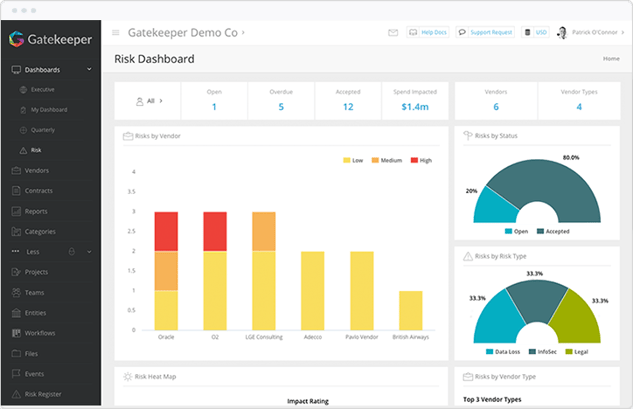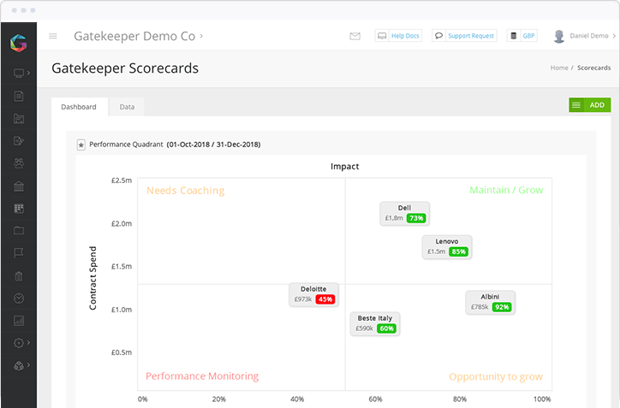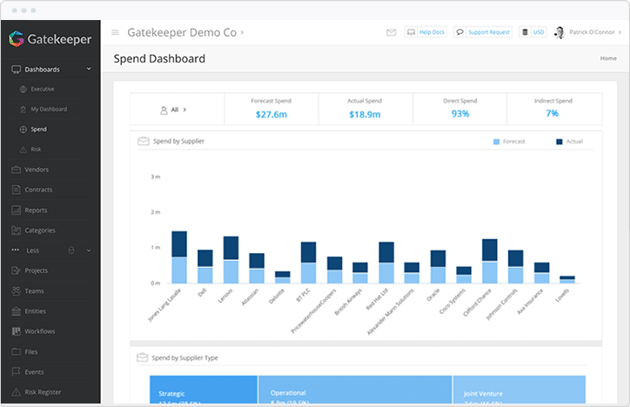Well-conceived procurement strategies are key to creating a reliable, cost-effective and resilient vendor base for your business’s most important areas of spend. There are different choices to be made when it comes to the approach with supplier optimisation, risk mitigation and cost reduction often being the main priorities.
Creating a procurement strategy isn’t just a one-off task. It requires dedication and meticulous planning from the outset and evolves as the vendor base matures and the business grows.
A universal procurement strategy will require multiple iterations as you look to stay ahead of your competitors and to get the best value at all times.
In this article, we take a look at how you can create and apply a coherent procurement strategy and how vendor management software can support your approach.
What is a procurement strategy?
Put simply, procurement is ‘the action of obtaining or procuring something’. For your business, procurement means obtaining services or goods that are relevant to its overarching objectives, internal requirements or customer needs. A procurement strategy needs to be aligned with the business’s overall objectives.
The purpose of the strategy - whether it’s to streamline the supplier base, minimise levels of risk or save costs - should be agreed and understood between teams at the outset for a robust and coordinated approach."
What should your procurement strategy include?
Regardless of the ultimate goal behind the procurement strategy there are a number of common factors every procurement process should have whether you’re starting from scratch or looking to optimise your current process. These include:
- The overarching business objectives that need to be achieved
- Deliverables (goods or services) that are needed to achieve these goals
- An understanding of current organisational spend
- Awareness of current operating conditions, trends and expected outlook
- The means to conduct market research
- A reliable RFP process
- A defined set of KPIs to measure various aspects of vendor performance
- Risk mitigation plans
- Regular reviews of the strategy’s effectiveness
Data collection and market analysis will be key to informed decision-making across the supply chain and will require input from a variety of teams and stakeholders. Resources will be needed to complete market research, make comparisons between different vendors and collect vendor information for any evaluation to take place.
Once vendors have been selected as part of the procurement process, cost and KPIs need to be negotiated and agreed.
There are a number of things your business needs to do once services have been procured and vendor management software can support your business through each stage.
Let’s take a look at how.
1. Create a central record of vendors and contracts
The ability to apply a successful procurement strategy across your business relies on a deep understanding of current relationships, current spend and any gaps in services or goods. By creating a central record of vendors and contracts you can minimise the potential for business risk and delinquent spend.
Vendor management software offers a central repository that makes it easy to access all the information you need from a single location, increasing your visibility of the contract portfolio and each of your vendors.
With this centralised view, you can more easily spot any potential issues - such as unplanned duplicate spend or insurance certifications that are coming up for expiry - and act quickly.
A complete understanding of your vendors, their risk status and upcoming key dates will underpin stronger relationships and a more sophisticated strategy for maximising value across the supply chain."
2. Optimise collaboration with third-parties
The way you onboard, communicate with and manage your vendors will have a defining impact on the quality of the relationship moving forward. Vendor relationship management will always be a key procurement trend.
Dedicated software that includes a Vendor Portal creates greater efficiencies for your business and a streamlined experience for your vendors by:
- Automating vendor onboarding and compliance
- Accurately building vendor profiles through data capture
- Capturing all relevant information in a desired format
- Notifying vendors when they need to update information
- Creating a fully defensible audit trail of all communication with vendors
- Digitising your procurement processes at every stage from RFPs to renewals
Using vendor management software to automate and optimise your collaboration with third parties will reduce manual errors, save your internal teams valuable time and allow your business to make informed decisions with your vendors based on accurate information."
3. Minimise and mitigate risk
If your approach to vendors is fragmented, you are exposing your business to numerous risks including financial, regulatory and reputational. Fragmentation can ultimately lead to chaos within your business and within your vendor relationships, causing different scenarios such as:
- Missing documentation that leads to non-compliance
- Lack of awareness around poor vendor performance
- Unfulfilled contract obligations going unnoticed
- Poorly timed escalations that can lead to operational failure
- A lack of audited history evidence to help resolve disputes
- Poor user and vendor satisfaction
- Ineffective business continuity planning
An effective procurement strategy means taking control of data, centralising your information and standardising your processes. Vendor lifecycle management software can eliminate the chaos by helping you to visualise and automate even the most complex processes through a dedicated workflow engine.

Gatekeeper's Risk Module
This level of automation gives you greater control at every stage, enhancing the risk management efforts within your procurement strategy through escalation workflows that trigger exactly when you need them to.
One way to trigger escalation workflows to help you mitigate risk is to assign a Risk Score to each supplier. Calculated from the probability of events happening and the impact it will have across your business, a high risk score can be used to automatically trigger escalation and help you to put your mitigation plans into action.
4. Measure performance
Strategic procurement strategies are ones that keep monitoring and measuring the success of the vendors involved. Before onboarding vendors, a set of KPIs should be defined that they can be continuously measured against.
A performance review should occur at a frequency commensurate with the vendor’s importance such as once a quarter up to once a year, but how do you plan for the time, the workload and the resource?
Vendor management software can be used to streamline this review process as well as provide an accurate up-to-date snapshot of how your vendor is performing through Balanced Scorecards, data-driven dashboards and automated performance tracking.
 Gatekeeper's Balanced Scorecards
Gatekeeper's Balanced Scorecards
Not only can you measure, collect and analyse data about your vendors’ performance, but you can also share this information with them. This in turn helps drive corrective actions to improve areas of weakness.
By using vendor management software to support your procurement strategy, not only will you drive better performance across your supply chain but you will also be able to hold your vendors to account, extract maximum value and increase ROI across your business.
5. Assess vendor spend
Hidden and indirect spend are two areas that commonly weaken a procurement strategy and drive costs up across a business.
It’s crucial to understand the spend culture across your organisation and adjust vendor spend accordingly. Spend analysis can help you to drill down into business-critical issues such as:
- What forecast vs actual spend is
- How direct spend vs indirect spend is impacting your business
- If there are multiple vendors supplying the same goods or services
- Cost differences between multiple vendors
- The true cost of third-party expenditure
Vendor management software will give you a centralised view of this essential information and help you to automate your processes around spend capture.
 Gatekeeper's Spend Module
Gatekeeper's Spend Module
You can easily import spend data from existing finance systems within your business to achieve a comprehensive view of what’s being spent in all areas of your business and across all vendors.
With dedicated Spend Dashboards, you can see spend by Supplier Type and spend by Supplier, giving you all the insights you need to take back control of your costs.
6. Manage renewals and negotiate effectively
Spend analysis and negotiation go hand-in-hand and can help you to streamline your supplier base. By analysing your spend, you can use the information gathered - such as the ongoing value of the contract - to strengthen your negotiating position to achieve better terms ahead of renewal.
Spend analysis can also be a key factor in deciding whether you do decide to renew or if close-out is simply the more cost-effective option for your business.
There are some key steps you need to build into your procurement strategy so that you can effectively manage your renewals and reach a powerful negotiating position:
- Record key dates centrally
- Build in time for a contract review
- Have a clear strategy for engaging your supplier
- Determine if expected benefits and value-for-money have been achieved
A successful procurement strategy will open up opportunities to realise greater value and results for existing vendors within the portfolio and to identify cost-effective alternatives available on the market."
Procurement should focus on obtaining the desired quality and value goods and services at all times - not just at the start of a relationship.
Use vendor management software to optimise this process with automated alerts ahead of key dates so you can understand the current value being delivered by third parties and make renewal decisions ahead of time. Pre-emptive action will mean you never miss another renewal opportunity again.
You can learn more about building renewal processes into your procurement strategy by watching the webinar below.
Conclusion
Strategic procurement plans should be applied after careful consideration and with business structure and goals in mind. Acknowledging that procurement is an ongoing process rather than an activity that ends at the point of contract initiation will help you to better align different departments across the business and improve collaboration with third parties. Investing in a vendor management platform can support your processes.
Gatekeeper helps businesses to identify cost-saving and performance improvement opportunities, and helps them to better manage their renewals and negotiations. This means business can minimise risk, maximise value and yield the benefits of deep, collaborative relationships across the supply chain.
If you want to know more about how vendor management software can support your your approach to strategic procurement, book your Gatekeeper demo today

.png)
.png)
.png)
-4.png)